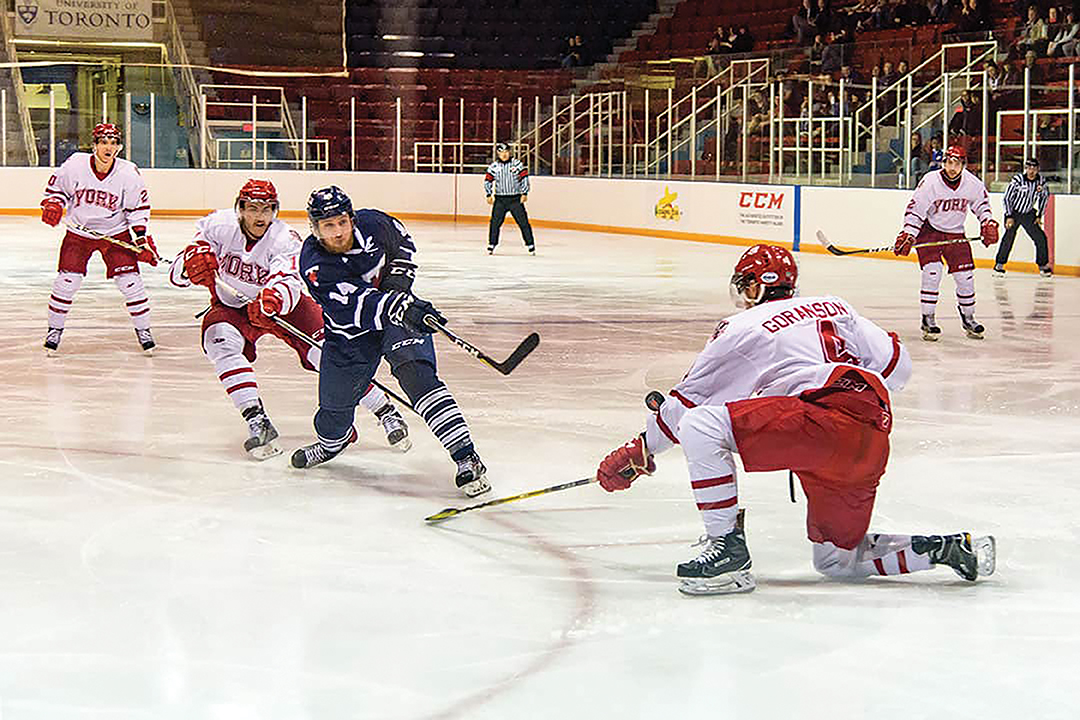In 1984, Marc Garneau became the first Canadian astronaut to fly in space. On his journey, he brought one very special object with him: a hockey puck. This isn’t a surprise to most Canadians as hockey is beloved by many, with an average of 460,000 viewers per game for the 2021–2022 season.
From the ice to the skates to the execution of the slapshot, science can explain all the aspects of Canada’s favourite game. Alain Haché breaks down all the details in his 2002 book, The Physics of Hockey.
Keeping it cool
The science behind ice has been vastly studied, but the main factor to note is that it’s slippery.
In 1686, Sir Isaac Newton proposed three laws of motion, which explain how forces can act on an object. His third law of motion states that “every action has an equal and opposite reaction.” When you run, for example, your feet exert a force on the ground, and the ground exerts a force of equal magnitude in return, which allows you to push off.
However, the position of the feet and the direction of the force cannot optimally translate on ice due to the lack of adequate friction between skates and the ice.
Lace ‘em up!
Hockey skates are engineered to improve speed, agility, and control on ice. The blade on these skates has an arc-shaped groove at the end, which creates a small, empty area underneath the blade. An immense amount of pressure is exerted onto this area, which results in the edges of the blade digging into the ice and providing grip to counteract the ice’s slippery nature. As a result, the skater can accelerate and brake instantaneously.
Regular skaters and hockey players know how important it is to sharpen the blades on their skates. One important reason for this is braking. The sharper the blades, the deeper the blade can dig into the ice, which increases the frictional force when slowing down. When skaters want to brake, they must straighten themselves and turn one or both skates sideways. This motion provides a resistive force and, as a result, the blade scratches off a thin layer of ice.
However, even with perfectly engineered boots, skating is very difficult. Skating forwards entails orienting one foot at an angle with the toes pointing out while the other foot is gliding forward. The foot at an angle will push off the ice and the ice reacts with its own force, allowing the skater to propel forward.
Scoring beauties
Scoring is essential to all competitive sports, and in hockey, the most exciting score is the slapshot. Invented by Bun Cook in the 1930s, the slapshot is a fierce interaction between the stick and the puck. Although the slapshot is great when a player is further away from the goal because of the extra speed, it does have a downside: it is not very accurate.
The slapshot consists of three stages. The first is the wind up, where the player brings the stick behind themselves and begins turning their torso. Then, the stick makes contact with the ice and the puck. This action is crucial, because the force with which the stick hits the ice causes the stick to bend and load up with potential energy, also known as stored energy. Finally, this potential energy is converted to kinetic energy upon contact with the puck, allowing the puck to accelerate.
NHL players can achieve immense puck speed when correctly utilizing the slapshot. In fact, the current record for the fastest slapshot is held by Zdeno Chara, who then played for the Boston Bruins. He scored a slapshot with a speed of 175.1 kilometers per hour in the 2012 All-Star Skills Competition! Perhaps, if hockey players learn about the science behind the speed, they can set a new record in 2023.


